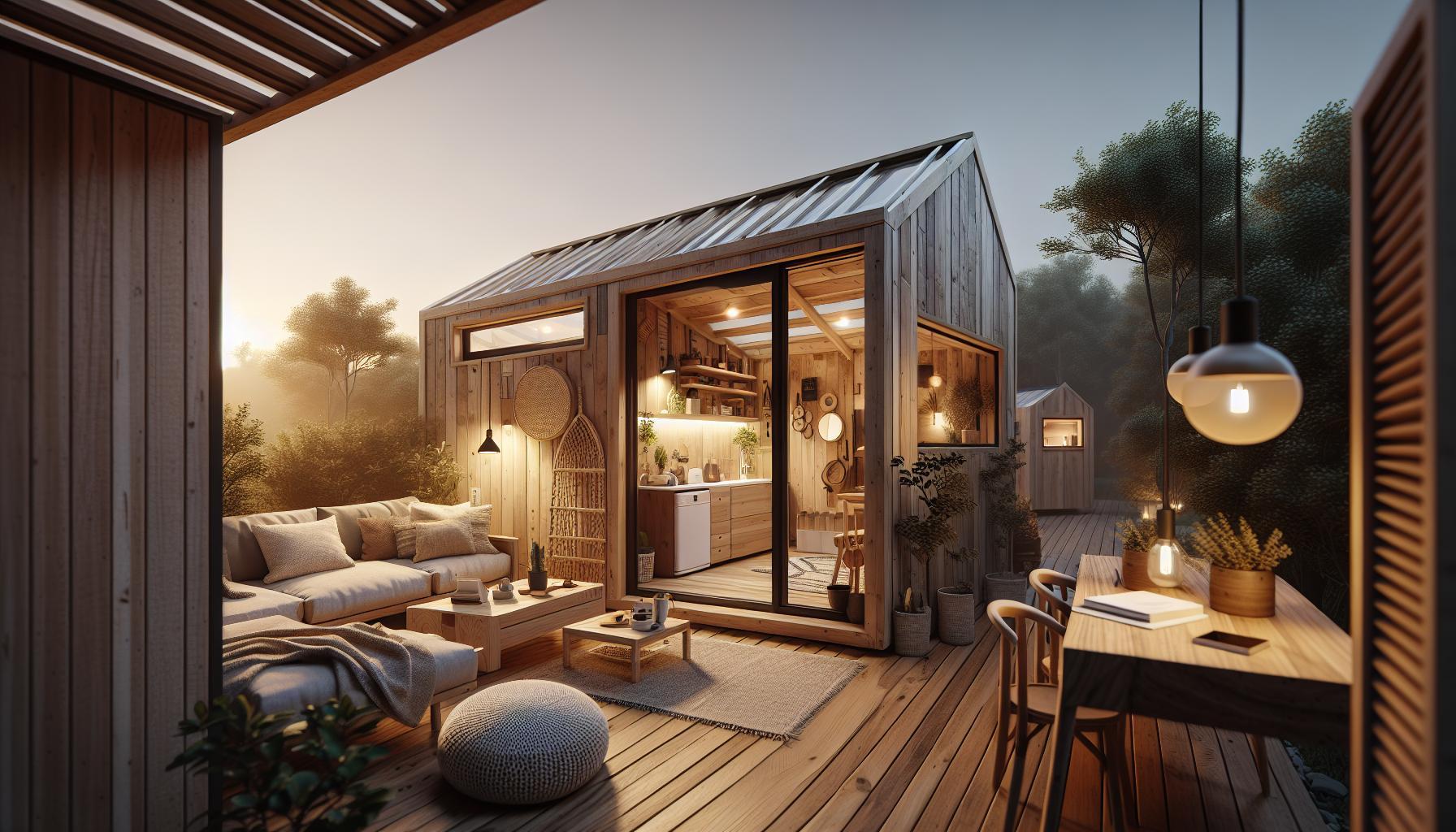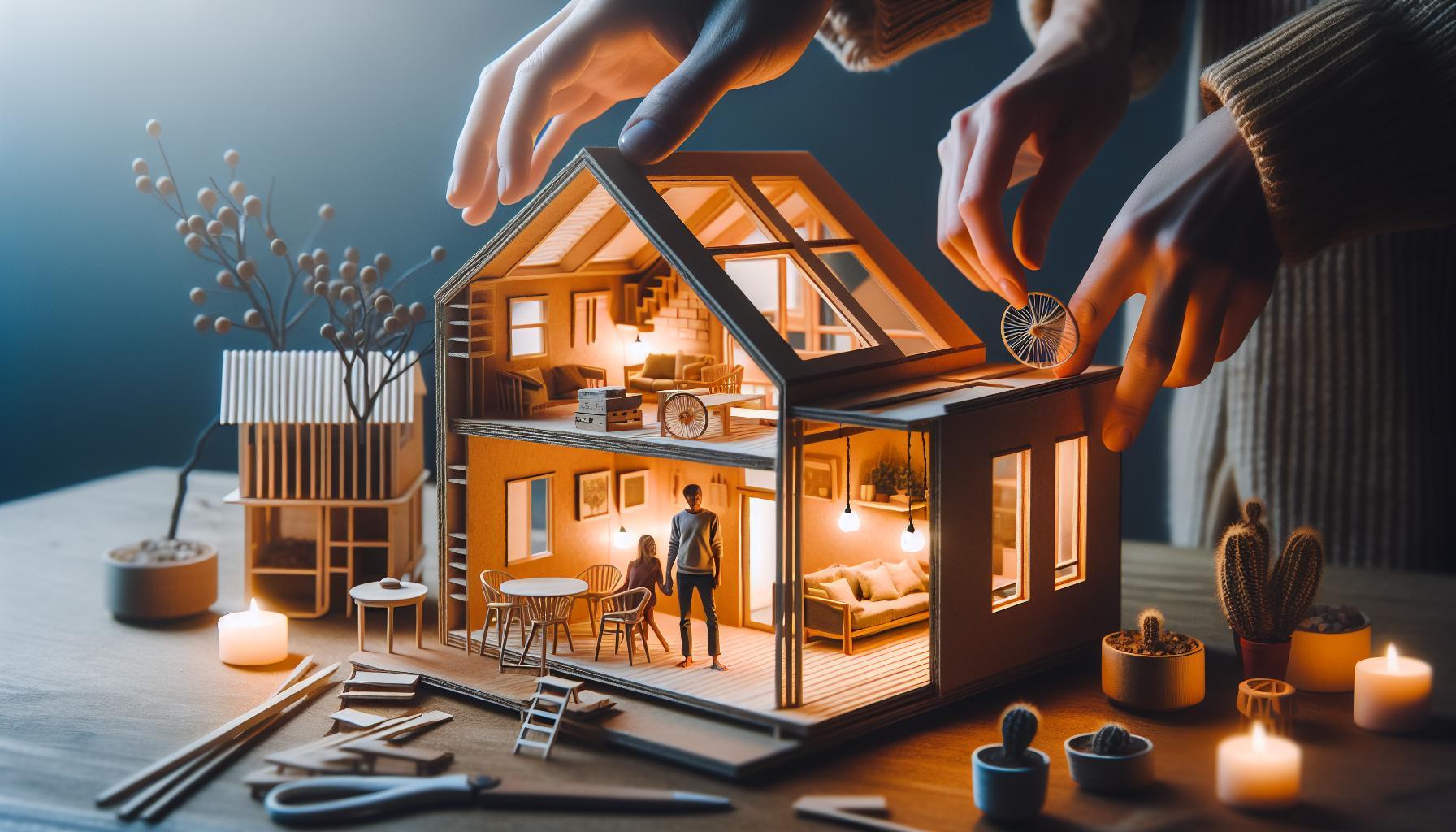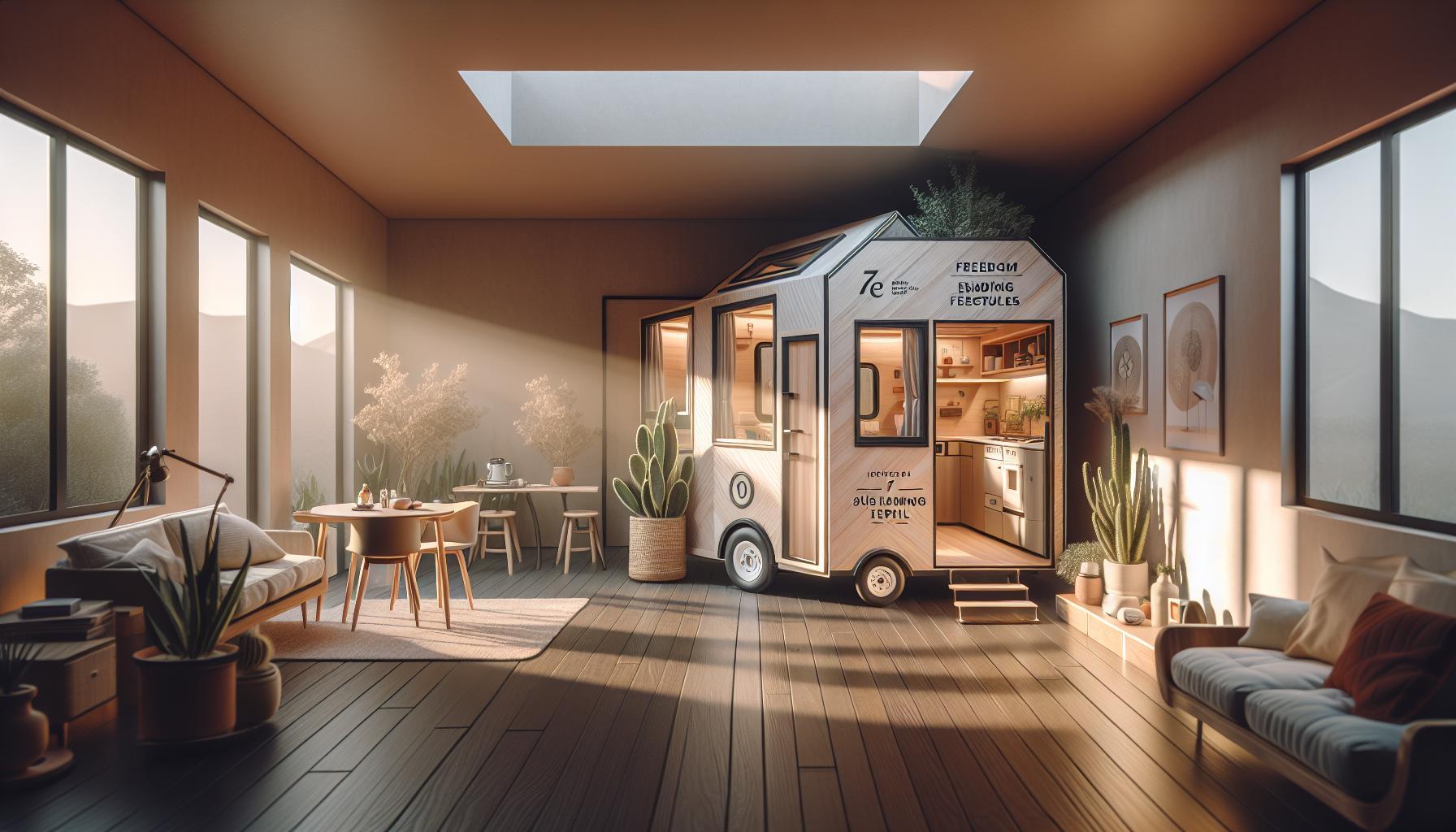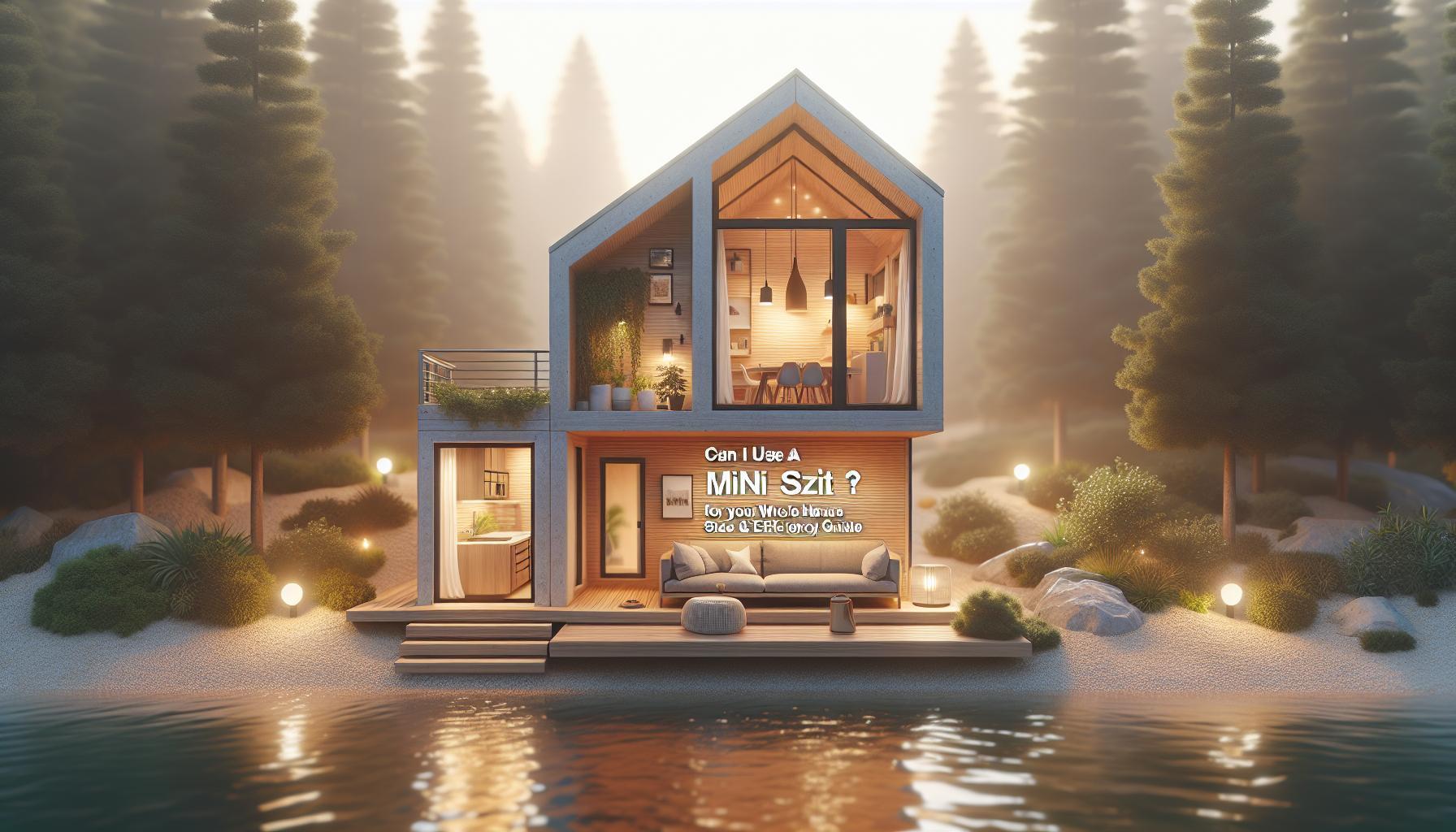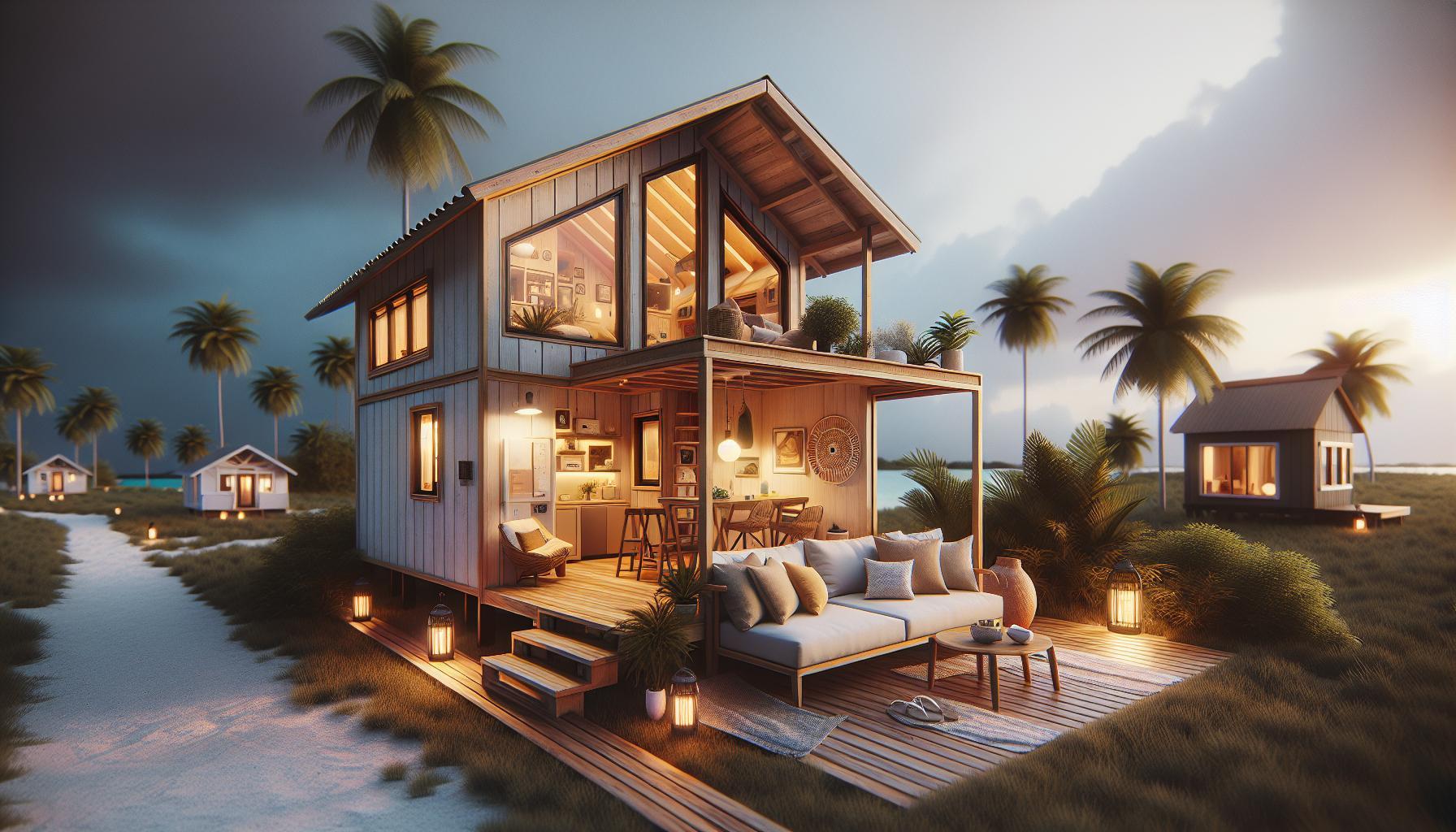As the world seeks greener living solutions, tiny houses emerge as a compelling answer to sustainability challenges. These compact dwellings offer remarkable eco-benefits, from reduced energy consumption to minimal waste generation. Discover how adopting a tiny lifestyle not only promotes environmental duty but also enchants those passionate about enduring living.
The Philosophy of Minimalism: Why Choose a Tiny House?
The rise of tiny houses has sparked a movement that embraces minimalism, a philosophy rooted in the idea that less can indeed be more.This approach to living encourages individuals to focus on what truly matters—essentially shedding the excess and cultivating a lifestyle that prioritizes experiences over possessions. As people become increasingly aware of environmental issues, the intersection between minimalism and sustainability becomes evident, especially in the context of tiny house living. The choices made in tiny homes align closely with eco-conscious values, reflecting a commitment to a resource-efficient way of life.
Living in a tiny house naturally prompts a significant reduction in consumption and waste. With limited space, residents are compelled to consider every item they bring into their homes, fostering mindful purchasing habits. Embracing minimalism can lead to considerable eco-benefits:
- Lower energy consumption due to reduced square footage.
- Decreased need for material goods, which reduces manufacturing and landfill waste.
- Increased use of sustainable materials in tiny house construction.
Moreover, tiny houses often serve as a conduit for fostering community ties and promoting a simpler lifestyle. Many tiny home communities prioritize shared resources—like gardens, workshops, and facilities—further reducing individual carbon footprints.By building a life centered around community and sustainability, tiny houses embody the essence of minimalism while challenging the conventions of traditional living.
the philosophy of minimalism not only encourages a reduced ecological footprint but also enhances personal well-being.Living in a tiny house can lead to less financial stress, giving individuals the freedom to invest more time in relationships, hobbies, and nature—all integral components of fulfillment. by understanding the deeper motivations behind the tiny house movement, individuals can appreciate how this lifestyle not only provides practical benefits but also aligns with a broader vision of a sustainable future, as discussed in the insights from “Are Tiny Houses Sustainable? 7 Eco-benefits That Will Amaze You.” The choice to downsize is more than a trend; it’s a deliberate commitment to enriching lives and preserving the planet.
Understanding the Resource Efficiency of Tiny Living
The movement toward tiny living is not just about downsizing; it encompasses a deeper commitment to resource efficiency and sustainable living. Tiny homes, often significantly smaller than traditional houses, inherently reduce the volume of building materials required, the land needed, and the energy consumed. This smaller footprint translates into a wide array of environmental benefits, making tiny living a powerful example of how individuals can live in harmony with the planet.
Maximized Resource Efficiency
Due to their compact nature, tiny homes encourage innovative use of space and resources. Homeowners are more inclined to invest in multipurpose furniture and smart design solutions that optimize living areas without sacrificing comfort. For instance, a fold-out table that doubles as a workspace and dining area helps minimize unnecessary materials and utilizes space efficiently. Energy-efficient systems, including appliances designed for smaller spaces, also play a crucial role in maximizing efficiency. By selecting energy-rated devices, tiny homes can drastically cut down on energy consumption while maintaining functionality.
Reduction of Waste and Resource Consumption
In the quest for resource efficiency, tiny living promotes a culture of minimalism and intentionality. Residents frequently enough embrace sustainable practices by reducing their overall possessions and waste. This shift not only decreases landfill contributions but also fosters a lifestyle centered around mindfulness. Incorporating strategies such as composting, rainwater harvesting, and using solar panels can drive further resource efficiency. Homeowners can effectively reduce their reliance on public utilities and minimize their environmental impact while enjoying more autonomy over their living resources.
Integration of Sustainable Practices
Beyond reducing their immediate resource consumption, many tiny homes are designed with sustainability at their core. For example, utilizing recycled materials in construction can significantly lower environmental impact. Harvesting local resources for building and incorporating energy-efficient designs deepen the sustainability credentials of tiny homes. Implementing passive solar design principles helps optimize natural light and temperature regulation, which can drastically reduce heating and cooling needs. These practices reveal that tiny living is more than just a trend; it represents a viable pathway toward sustainable living that could inspire broader changes in the housing sector.The eco-benefits of tiny living demonstrate that less can indeed be more. As people increasingly ask, “Are tiny houses sustainable?” it’s clear that embracing resource efficiency can lead to healthier lifestyles, reduced environmental footprints, and ultimately, more resilient communities. Each decision made in the design and function of tiny homes contributes to not only personal well-being but also a larger movement toward global sustainability.
Renewable Energy Solutions for Tiny Homes: powering Your lifestyle
Imagine generating all the energy you need from the comfort of your compact sanctuary—a tiny home. As the conversation around sustainable living continues to evolve, many homeowners are turning to renewable energy solutions to power their lifestyle. By integrating sustainable energy sources into tiny homes, individuals can significantly reduce their carbon footprint while enjoying the freedom that comes with off-grid living.
Solar Power: Harnessing the Sun’s Energy
One of the most popular choices for tiny homes, solar power is not only renewable but also offers a reliable energy source with relatively low maintenance. With advancements in technology, tiny homeowners can choose from several types of solar panels. Monocrystalline solar panels, renowned for their efficiency and sleek design, are a great option for maximizing power generation on limited roof space. Additionally, installing solar batteries can help store excess energy for nighttime use, ensuring that your home is powered regardless of the time of day.
- Advantages: Reliable, low maintenance, scalable.
- Considerations: initial installation cost and space for panels.
Wind Power: Capturing Nature’s Breeze
wind energy is another compelling option for tiny homes, especially in areas with consistent wind flow. Small-scale wind turbines can complement solar installations, providing an alternative energy source. These systems frequently enough include battery storage to ensure that energy is available even when the wind isn’t blowing. Selecting the right turbine size is critical; a turbine that’s too large may require more space and financial investment than necessary.
Water Power: Tapping Into Local Resources
For tiny homes near water bodies, micro-hydro power systems present an excellent opportunity. By utilizing flowing water to generate electricity, these systems can provide continuous energy, making them incredibly efficient. Much like wind turbines, micro-hydro setups need a relatively stable water flow to work effectively, but they can produce a significant amount of power for minimal environmental impact.
Hybrid Energy Solutions
Combining various sources of renewable energy can offer the most reliable power solution for tiny homes. A hybrid system might use solar panels as the primary source, supplemented by wind turbines and a water power system when conditions allow. This multifaceted approach ensures energy availability throughout the year. However, it is essential to have a robust power management system to seamlessly switch between sources and manage energy storage effectively.
| Energy source | Advantages | Considerations |
|---|---|---|
| Solar Power | Reliable, Minimal Maintenance | Space for Panels |
| Wind Power | Clean, Abundant | Requires Consistent Wind |
| Water power | Continuous Energy Supply | Requires Flowing Water |
Integrating renewable energy solutions into tiny homes plays a vital role in promoting sustainability. By exploring these options, homeowners can not only enjoy significant costs savings but also contribute to a more eco-amiable planet. embracing the eco-benefits of tiny houses, such as efficient energy use, is a step toward a greener future, reinforcing the idea that sustainable living is both achievable and beneficial.
Smart Design: How Size Fuels Creativity and Functionality
The charm of tiny houses lies not only in their small footprint but in the innovative design strategies that transform limited space into a realm of creativity and functionality. These miniature marvels challenge conventional living by embracing simplicity while maximizing every square inch. As the tiny house movement gains momentum,understanding how size can fuel design ingenuity is crucial for anyone considering downsizing or embarking on a sustainable lifestyle.
Creative Use of Space
In tiny homes, the design must cleverly integrate multiple functions within a single area, fostering a unique harmony between aesthetics and utility. For instance, dining tables often double as workspaces, and lofted beds free up ground space for living areas. Smart storage solutions, like built-in shelves and hidden compartments, ensure that every corner serves a purpose. This efficient utilization encourages minimalism, helping residents reduce clutter while maintaining a stylish and practical living environment.
Integrating Nature Inside
One remarkable feature of tiny houses is their ability to harmonize indoor and outdoor spaces.Large windows and glass doors not only enhance aesthetics but also invite natural light and breathtaking views,creating an illusion of spaciousness. Incorporating natural elements, such as indoor plants, not only brightens the space but also contributes to better air quality, promoting a healthier living environment—an essential consideration in evaluating the sustainability of tiny houses.
Eco-Friendly Materials and Technologies
Emphasizing sustainability, many tiny houses utilize eco-friendly building materials like reclaimed wood, bamboo, or recycled metals.These choices not only reduce environmental impact but also frequently enough come with unique character and charm. innovative technologies, including solar panels and efficient appliances, further enhance the sustainability factor. Such smart design elements not only make tiny homes stand out but also affirm their position as a responsible alternative to larger, energy-intensive houses.
| Design Element | Functionality | sustainability Impact |
|---|---|---|
| Multi-functional Furniture | Transforms spaces for various needs | Reduces need for excess items |
| Natural Light Sources | Enhances open feel | Minimizes energy usage |
| Eco-Friendly Materials | Durable and aesthetically pleasing | Lower carbon footprint |
| Green Technologies | Improves energy efficiency | Utilizes renewable resources |
in navigating the question of sustainability, the design philosophies behind tiny houses illuminate a path where creativity flourishes within confined spaces. The blend of thoughtful design, eco-friendly principles, and innovative functionality positions tiny houses as more than just homes; they embody a lifestyle choice that values both the planet and personal well-being, making them an increasingly appealing option for modern living.
Water Conservation Techniques in Tiny house Living
Living in a tiny house not only simplifies life but also provides a unique opportunity to implement innovative water conservation techniques. With limited space and resources, tiny house residents can adopt a variety of methods to reduce water usage, ensuring that their living environment remains sustainable while minimizing their ecological footprint. By focusing on efficient systems, every drop counts, contributing to both environmental conservation and practical living.
Rainwater Harvesting
One of the most effective ways to conserve water in tiny homes is through rainwater harvesting. By installing gutters and collection barrels, homeowners can capture rainwater from their roofs. This collected water is not only available for non-potable uses such as flushing toilets or watering plants, but it can also be filtered and treated for potable purposes. According to a study on tiny living, implementing rainwater systems significantly decreases dependency on municipal water supplies, particularly beneficial for those living off-grid [[2]](https://tinyhouseblog.com/tiny-house/the-importance-of-quality-water-and-air-in-a-tiny-living-space/).
Greywater Recycling
Another sustainable technique is greywater recycling, which involves the repurposing of wastewater from sinks, showers, and laundry for irrigation or toilet flushing. This can drastically reduce overall water consumption. Small-scale greywater systems, which are manageable in tiny home settings, can filter and redirect this water safely. It’s crucial to use biodegradable soaps and cleaning products to ensure that the recycled greywater remains safe for plants and the environment [[1]](https://www.habitatista.com/13946/best-water-conservation-strategies-for-tiny-home-residents/).
Mindful Usage and Efficient Fixtures
Being mindful of water usage is essential in tiny homes. Installing low-flow fixtures, such as showerheads and faucets, can significantly cut down on water waste. Residents can take shorter showers, fix leaks promptly, and use a basin for washing dishes to conserve water further. Simple habits, like turning off the tap while brushing teeth or capturing shower runoff, can result in substantial water savings over time. For instance, one study indicated that switching to water-efficient appliances in tiny homes can lead to reductions of up to 50% in water usage [[3]](https://www.habitatista.com/13179/integrating-water-conservation-into-tiny-home-design/).
Practical Implementations
Integrating these water conservation techniques into daily living not only supports sustainability but also enhances the tiny living experience. Homeowners can maintain gardens using greywater, rely on rainwater for irrigation, and adopt strategies for mindful consumption. Such practices not only help in reducing water bills but also demonstrate a commitment to eco-friendly living.As tiny house enthusiasts continue to explore the eco-benefits of their lifestyle, these conservation strategies exemplify the potential for sustainable living, reinforcing the notion that tiny houses truly can be sustainable in many facets, including water management.
Building with Nature: Sustainable Materials for Your Tiny Abode
Embracing sustainability in the construction of your tiny home not only contributes to a healthier planet, but it also enhances your living experience. By carefully selecting eco-friendly materials,you can significantly reduce your environmental footprint while creating a warm and inviting space. Opting for sustainable materials helps in conserving natural resources,minimizing waste,and promoting energy efficiency—key elements in the conversation around whether tiny houses are sustainable.
One of the most effective strategies for building sustainably is to incorporate materials that are both renewable and have a lower carbon footprint.Hear are some exemplary materials to consider:
- Reclaimed Wood: This material is not only visually appealing but also helps reduce deforestation.Using reclaimed wood for flooring, walls, and furniture is an eco-conscious choice that adds character to your tiny abode.
- Straw bale: Known for its excellent insulation properties,straw bale construction is an affordable and environmentally friendly alternative that promotes energy efficiency.
- Recycled Steel: Utilizing recycled steel for structural elements ensures durability and helps lessen the demand for new steel production, which is energy-intensive.
- sustainable Insulation: Materials such as sheep’s wool, hemp, or recycled denim provide insulation that is not only effective but also safe and sustainable.
choosing Eco-Friendly Finishes
The finishes you choose can greatly influence the sustainability of your tiny house. Non-toxic paints, natural sealants, and finishes derived from plant-based materials help improve indoor air quality while keeping your living space beautiful. Opting for finishes that contain low or no volatile organic compounds (VOCs) ensures a healthier environment for you and your loved ones.
Using renewable energy sources also plays a crucial role in tiny house sustainability. Incorporating solar panels and energy-efficient appliances can reduce your reliance on fossil fuels, further solidifying the green credentials of your home. Additionally, harvesting rainwater for your water needs not only lowers your ecological impact but also enhances your self-sufficiency.
| Material | Benefits |
|---|---|
| Reclaimed Wood | Reduces deforestation, adds character, minimizes waste. |
| Straw Bale | Excellent insulation, affordable, promotes energy efficiency. |
| Recycled steel | Durable, lessens demand for new materials. |
| Sustainable Insulation (e.g., sheep’s wool) | Effective insulation, renewable, safe. |
By adopting these materials and methods, your tiny home can become a shining example of sustainable living, perfectly aligning with the principles suggested in the discussion of the numerous eco-benefits of tiny homes. As more people explore the tiny house movement, the commitment to sustainability through the careful selection of materials is crucial for creating a truly eco-friendly living environment.
Financial Freedom Through Tiny House Living: A Sustainable Investment
Choosing to live in a tiny house can be a transformative decision that not only reduces your environmental footprint but also opens the door to significant financial freedom. in a world where traditional home ownership comes with hefty mortgages and ongoing maintenance costs, tiny house living offers a refreshing alternative. It underscores the principle of minimalism, allowing individuals to reallocate their financial resources toward experiences rather than possessions. With lower costs of living and a lifestyle that prioritizes sustainability, tiny homes are emerging as a viable path to financial independence.
One of the central tenets of tiny house living is its potential for substantial cost savings. Residents frequently enough experience lower utility bills, reduced property taxes, and decreased maintenance costs. This shift means that owners can save and invest money more effectively. Here are some financial benefits that highlight how tiny houses can lead to long-term savings:
- Reduced Consumption: Tiny homes facilitate a minimalist lifestyle, encouraging inhabitants to buy less and live simply.
- Lower Utility Expenses: smaller spaces typically require less energy for heating and cooling, translating to lower electricity and water bills.
- Affordable Housing Options: Purchasing or constructing a tiny home can be significantly less expensive than acquiring a conventional home, making home ownership accessible to more people.
- Potential Rental Income: Tiny homes can also serve as lucrative rental properties or vacation homes, creating an additional income stream.
Additionally, many tiny home dwellers report a higher quality of life as a result of their lifestyle choices. Fewer expenses mean less financial stress, enabling individuals to focus on their passions, travel, or invest in other opportunities. Research indicates that individuals who adopt minimalism experience greater satisfaction and well-being, further reinforcing the idea that financial freedom can lead to enhanced life quality.
In essence, integrating sustainable practices with financial independence is increasingly popular, as illustrated in the eco-benefits discussed in various articles. As we examine the increasingly apparent advantages of tiny house living, the query of sustainability resonates deeply. Not only do tiny houses promote an environmentally friendly lifestyle, but they also create pathways to financial freedom, making them an investment in both your future and the planet. By choosing to downsize, individuals can reclaim their financial power while contributing positively to their communities and ecosystems.
faq
Are Tiny Houses Sustainable? 7 Eco-Benefits that Will Amaze You?
Yes, tiny houses are considered sustainable due to their minimal environmental impact. They require fewer resources for construction, use less energy, and promote a minimalist lifestyle that reduces waste.
Tiny houses typically utilize energy-efficient materials and appliances,which drastically lower electricity consumption compared to traditional homes. Additionally,their small size encourages less material use and fosters a lifestyle that emphasizes reducing,reusing,and recycling,making tiny homes an excellent choice for eco-conscious individuals.
What is the carbon footprint of tiny houses compared to traditional homes?
Tiny houses have a significantly lower carbon footprint than traditional homes. This is primarily as they use fewer materials and less energy to heat and cool the living space.
For instance,a traditional house would need to house at least ten people to have lower per-person emissions than a typical tiny home. this efficiency highlights the environmental benefits of tiny living and reinforces the movement’s focus on sustainability.
How do tiny houses promote sustainable living practices?
Tiny houses promote sustainable living practices through their compact design, which encourages occupants to adopt eco-friendly habits, such as conserving water and minimizing waste.
Many tiny home dwellers implement solutions like solar power systems, composting toilets, and rainwater harvesting. These practices help reduce reliance on conventional utilities and minimize environmental impact, making tiny houses a practical choice for those committed to sustainability.
Can I live off the grid in a tiny house?
Yes, many tiny house enthusiasts successfully live off the grid, relying on renewable energy sources and self-sufficient practices.
Living off the grid in a tiny home often involves using solar panels, composting systems, and water catchment strategies. However, this lifestyle can present challenges such as finding suitable locations and managing storage space for essential supplies. Engaging with local communities can aid in overcoming these hurdles.
Why does the tiny house movement emphasize minimalist living?
the tiny house movement emphasizes minimalist living as it encourages individuals to prioritize experiences over possessions,reducing clutter and environmental impact.
Living in a smaller space fosters a simpler lifestyle, allowing for more time spent on activities that truly matter. This shift in mindset reduces consumption and supports sustainable living approaches, aligning with the key principles of the tiny house philosophy.
What are some challenges of tiny house living related to sustainability?
While tiny house living has many sustainable benefits, there are challenges, such as local zoning laws and limited storage space.
Many municipalities have strict regulations that can hinder tiny house placement. Homeowners frequently enough need to navigate these legal complexities to ensure compliance. Furthermore, living in a smaller space requires creative solutions for storage and waste management, which can be a learning curve for new tiny house dwellers.
How can I incorporate eco-friendly practices in my tiny house?
You can incorporate eco-friendly practices in your tiny house by using sustainable materials, energy-efficient appliances, and smart home technology.
Additionally,consider implementing systems for waste reduction,such as composting toilets and recycling bins. By selecting eco-friendly products and being mindful of resource consumption, you can significantly enhance the sustainability of your tiny living space.
To Conclude
tiny houses offer remarkable sustainability benefits that resonate deeply with both environmental values and minimalist living philosophies. By embracing reduced resource consumption, utilizing renewable energy sources like solar panels, and minimizing waste, these homes not only lower your ecological footprint but also promote a simpler, more intentional lifestyle. The community surrounding tiny houses supports innovation and a shared commitment to sustainability, often resulting in eco-friendly designs that are as stylish as they are functional.Though, it’s essential to navigate the practical challenges of legal regulations and space limitations thoughtfully. For anyone looking to explore the tiny house movement further, consider how these sustainable practices can enrich your life while contributing positively to the environment. Join the conversation and share your experiences, insights, or questions about making tiny living a reality!

